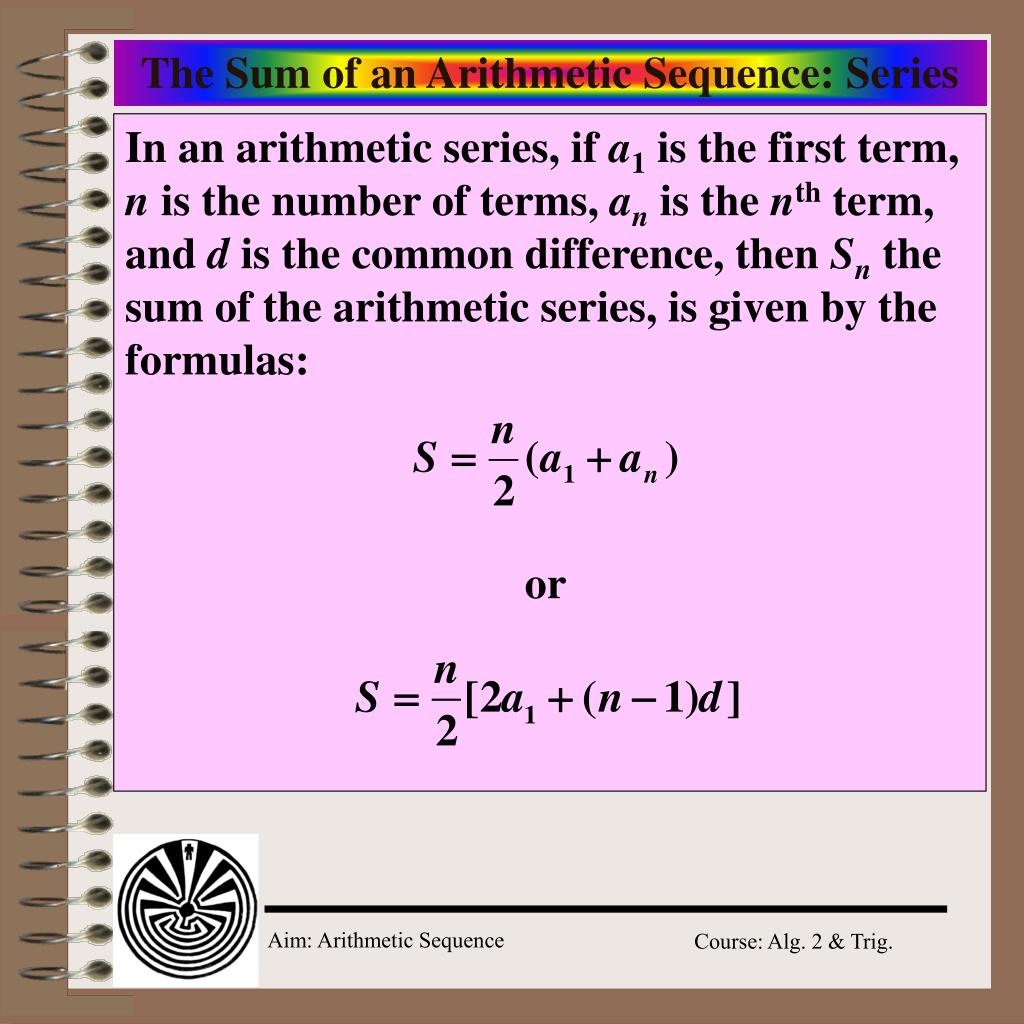
- #Sum of arithmetic sequence code
- #Sum of arithmetic sequence series
If we exclude the $n$th term from the first sum, then $S_1$ is now $(n-1)(9+n)$, and the problem will have an integer solution. This is because I understood the first sum to be from the first term to the $n$th term inclusively. If you solve this, you'll note that $n$ is not a whole number.
#Sum of arithmetic sequence series
C++ Program to find the sum of the series 23+ 45+ 75+….First, note that you can sum the first $n$ terms in an arithmetic sequence using this trick of pairing the biggest with the smallest:. Program to check we can make arithmetic progression from sequence in Python. 8085 program to find the sum of series of even numbers. The sum of $3^$ term is $5k+1$, then find the sum of first $100$ terms. Python program to find the sum of sine series. 8085 program to find the sum of a series The nth partial sum of an arithmetic sequence can be calculated using the first and last terms as follows: Snn(a1+an)2. Missing Number In Arithmetic Progression using C++. C Program for N-th term of Geometric Progression series. Program to find sum of harmonic series in C++. This Python program allows the user to enter the first value, the total number of items in. Find the missing number in Arithmetic Progression in C++ Python Program to find Sum of Arithmetic Progression Series Example. #Sum of arithmetic sequence code
JavaScript code to find nth term of a series - Arithmetic Progression (AP). This difference is called common difference and the formula to compute the next number in the sequence is. An arithmetic sequence is an ordered series of numbers, in which the change in numbers is constant. C++ Program for sum of arithmetic series As you probably know, the arithmetic sequence is a sequence of numbers such that the difference between the consecutive terms is constant. 1.Make sure you have an arithmetic sequence. C Program for N-th term of Arithmetic Progression series. There are two ways to find the sum of a finite arithmetic sequence. And let's say it's going to be the sum of these. So let's call my arithmetic series s sub n. Sum of A.P series is: 3 + 8 + 13 + 18 + 23 + 28 + 33 + 38 + 43 + 48 = 255 So the arithmetic series is just the sum of an arithmetic sequence. When the above program is executed, it produces the following result − enter 1st no of series: 3 However, if the sequence is still finite but longer, it can be. is a geometric progression with common ratio 3. Since there are 59 11 2 + 1 25 terms in total, there remain 25 n terms to be. Equivalently, S terms 2 ( first + last) Now, suppose we sum the first n terms from the sequence 11, 13, 15,, 59. If the sequence is finite and short enough, calculating the sum of its terms is quite straightforward. In mathematics, a geometric progression, also known as a geometric sequence, is a sequence of non-zero numbers where each term after the first is found by multiplying the previous one by a fixed, non-zero number called the common ratio.For example, the sequence 2, 6, 18, 54. From the last line, we have S n 2 ( 2 a + ( n 1) d). Sum = (num * (2 * a + (num - 1) * diff)) / 2 An arithmetic series is the sum of the terms of an arithmetic sequence. 
Step 7: Compute tn by using the formula given below. Then the total of the fourth and ninth terms of this sequence equals five times the third term, which mean. Sum = (num * (2 * a + (num - 1) * diff)) / 2 A : Give n the sum of the first ten terms of an arithmetic sequence is 145, so S 10. Step 6: Compute sum by using the formula given below.

Step 5: Enter the common difference at runtime. Step 4: Enter total number of series at runtime. The sum of the arithmetic sequence formula is used to calculate the sum of all the terms present in an arithmetic sequence. since the sequence is quadratic, you only need 3 terms. that means the sequence is quadratic/power of 2. Step 3: Enter first number of series at runtime. this isn't an arithmetic ('linear') sequence because the differences between the numbers are different (5-23, 10-55, 17-107) however, you might notice that the differences of the differences between the numbers are equal (5-32, 7-52). Refer an algorithm given below to find the arithmetic progression. Here, total number of elements is mentioned as Tn. SolutionĪrithmetic Progression (A.P.) is a series of numbers in which the difference of any two consecutive numbers is always the same.

Find the sum of an arithmetic progression series, where the user has to enter first number, total number of elements and the common difference.







 0 kommentar(er)
0 kommentar(er)
